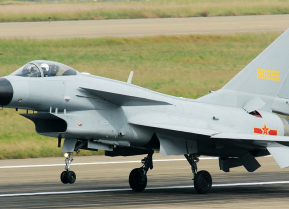Why China's "Top Gun" Video is Better Than Tom Cruise's Movie
Beijing has the need for speed--in the South China Sea.
I will make an unpatriotic confession.
I like the Chinese version of "Top Gun" better.
Or more specifically, a short Chinese navy video that resembles the 1986 Hollywood hit, for which a sequel is underway.
Well, almost resembles.
No smirking Tom Cruise. No fake love story (and no Kelly McGillis) to distract what everyone really came to see, which was the cool F-14 Tomcats zooming and booming through the skies. And at almost six minutes instead of almost two hours for the American version, it's a lot quicker to watch.
Not that the Chinese video is for entertainment: it's strictly propaganda (though the same could be said for the original Top Gun, to which the Navy happily contributed F-14s for the ultimate recruiting tool and budget-justifier).
The Chinese video was filmed during People's Liberation Army Navy (PLAN) exercises in the South China Sea earlier this year. It features an excellent sound track that conveys just the right amount of power and purpose.
Not surprisingly, the star of the show is the Liaoning, China's first aircraft carrier. The Liaoning is actually an ex-Soviet carrier laid down in the 1980s and never completed, until China bought and refurbished the rusting hulk. But in this video, it looks as awesome as an American Ford-class carrier, even though it's half the size. Filmed bow-on and steaming at the head of a column, and flanked by four escorts on either side, it looks as imposing an an American carrier battle group, even though it wouldn't last half a minute against a Ford- or Nimitz-class vessel.
Cue in the J-15 fighters shown launching from the ski-jump deck of the Liaoning and then maneuvering gracefully over the Pacific. There is the obligatory footage of missiles rising from surface ships atop pillars of fire, torpedoes splashing into the water, and the buzz of rapid-fire air defense cannon.
The hardware in itself is nothing we haven't seen before in many a navy's propaganda video. But what's most interesting about China's "Top Gun" is the image that it seeks to project. Despite all the weapons on display, there are only a couple of shots of missiles being fired, and no explosions or targets being hit. The theme is neither belligerent nor triumphant, nor even exhilarating like the Hollywood "Top Gun."
Recommended: What Will the Sixth-Generation Jet Fighter Look Like?
Recommended: Imagine a U.S. Air Force That Never Built the B-52 Bomber
Recommended: Russia's Next Big Military Sale - To Mexico?
Notable are the shots of the Liaoning's deck crew, clad in the various colors of their job, trotting to their stations in disciplined, perfectly aligned order. The ships and aircraft look well-maintained, majestically moving in formation. The word that best conveys this image is "professional."
Of course, the movie glosses over the cracks in the Chinese naval war machine. The J-15s are crashing so often that China is scrambling to find a replacement. The Liaoning may look like a nuclear-powered supercarrier, but it's a catapult-less carrier that limits the performance of the aircraft it can carry compared to those on catapult-launch American ships. Meanwhile, the Chinese military still suffers so much from corruption that the civilian government has to issue warnings and conduct purges.

Still, it was not that long ago that China was considered a land power, with an immense army and a bigger manpower pool that conjured images of human wave attacks. Now China is building a fleet of aircraft carriers, possibly with electromagnetic catapults similar to the most advanced American carriers.
The navy in this video appeared high-tech, professional, a real navy rather than a mere coastal defense force. Whether the video was aimed at foreign rivals or the Chinese public, the message was clear: China's navy is a force to be reckoned with.
Michael Peck is a contributing writer for the National Interest . He can be found on Twitter and Facebook.
Image #1, Creative Commons.
Image #2, Reuters.


